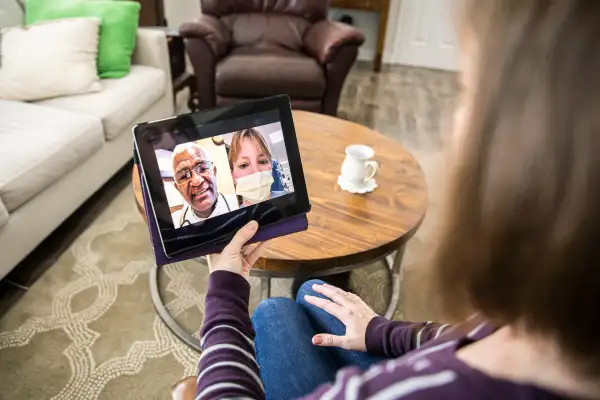Doctors and Patients Are Embracing Telehealth. But Will Insurers Continue to Pay for Virtual Visits Post-Pandemic?

“Call the doctor” has taken on a truly 21st-century meaning over the last few months. Rather than make an old-school house call, doctors have entered patients’ homes virtually during the pandemic, allowing people to maintain appointments through their smartphones and computers. But how long will it last?
Before the coronavirus, only 13% of patients in the U.S. had experienced a telehealth (also known as digital health) appointment with their doctors, according to consumer research firm Piplsay. This was due in part to the many barriers that prevented it from being a feasible tool of treatment. That number tripled almost overnight, with a third of Americans opting for telehealth during the pandemic. So far, the services have been popular among users, with 71% of patients reporting their telehealth appointments to have been an overall positive experience.
“Patients like the convenience of not having to sit around and wait for their doctor or take hours out of their day to travel to and from an appointment,” says Dr. Jacqueline Fincher, a member of the American College of Physicians and a general internal medicine doctor based in rural Georgia.
How Long Will Telehealth Last?
The CARES Act, the coronavirus relief plan Congress passed in March, temporarily lifted tight regulations that had prevented the widespread adoption of telehealth. But the provisions allowing telehealth to become widely accessible only exist “for the duration of the COVID-19 emergency”, according to the Centers for Medicare and Medicaid Services (CMS).
Patients wonder if the official state of emergency allowing them to receive routine medical care over phone or video will end sooner rather than later. Despite the continued nationwide increase in COVID-19 diagnoses, states have already been in the process of re-opening. And that can be a problem for patients with compromised immune systems and those who have busy lives or unreliable transportation options, who can benefit greatly from a telehealth option.
Dr. C. Freeman is a psychiatrist who works mainly with older adults in underserved areas of Los Angeles county. Some of her patients previously had to take up to three busses and a train to reach her offices, and they often experienced high levels of stress as a result of the long commute. With new telehealth measures in place, Freeman has noticed patients are more relaxed during sessions.
“There are a lot of things that can get in the way of people physically getting to your office,” says Freeman. “Now patients can be comfortable in their own apartment and maintain a level of anonymity using telemedicine in a way that they couldn’t otherwise.”
The future remains unclear for telemedicine. Private insurers usually take their cues from the government when setting policies, and so far the Centers for Medicare and Medicaid Services has not announced any permanent changes. But a CMS official hinted that the agency might be working toward a permanent expansion of telehealth, and that more details may be available soon, FierceHealthcare reported.
For many doctors, the desire to maintain telehealth is there — but not if insurers reimburse them for these vital services for much less than they’re worth. “They’ve wanted to compensate telemedicine at a lower rate than in person, as if the clinical skills have been diminished because of the mode of interaction, when actually, telemedicine requires a heightened level of attentiveness,” Freeman says.
Telemedicine can also help to shoulder the burden of community health centers that service low-income communities, which often have long wait periods and barriers that prevent people from receiving the care they need for months on end. From both the doctors’ and patients’ side, the implementation of telehealth has alleviated the some of the stress that comes with keeping appointments and dealing with bureaucracy.
“The genie’s out of the bottle,” says Fincher. “From a convenience point of view, nobody’s going to want to go back to not having the option.”
Fincher and her colleagues with the American College of Physicians are advocating for the expansions provided through the CARES Act to become law, at least through the end of 2021.
In a press release from July 7, America’s Health Insurance Plans, the membership organization for private insurers, advocated for regular restrictions on telehealth to be removed, stating that if these changes go away, “telehealth may be rolled back rather than becoming a sustained and transformational approach to patient care.”
When Should You See the Doctor In Person?
For now, most patients have the ability to choose between telehealth and in-person appointments. So when is it best to actually get to a doctor’s office, and when can you get the care you need from the comfort of your own living room?
The most widely known and successful implementation of telehealth before the coronavirus was in mental health counseling, since behavioral problems can be treated from anywhere. But the success of digital medicine doesn’t have to stop there. Patients with chronic illnesses like diabetes, autoimmune disorders, and heart disease might fare better with routine check-ups via a video or phone call, because they typically have their own tools for monitoring their vital signs and can avoid being put in situations that compromise their more fragile immune systems.
Fincher says a good rule of thumb is to just start off with a telehealth appointment: “We start with telehealth and see what might be the most obvious answer, if that answer’s not there then we ask them if they can come to the office.”
Of course, if the situation is an emergency (i.e. you’re bleeding excessively or have high pain levels) then a trip to the hospital is likely necessary, but Fincher says the goal of telehealth screenings is to help patients avoid unnecessary in-person visits and potential exposure to COVID-19.
To be sure, telemedicine might also come with more hassles than benefits for some. Those who have trouble hearing or have poor vision tend to struggle with digital appointments. Perhaps the biggest hurdle of all: the poorer, more rural communities telehealth is supposed to particularly benefit are also the most likely to lack access to broadband internet service or the modern smartphones and laptops required for successful digital appointments.
While it can never completely replace an in-person visit, Fincher believes doctors should see the option of telehealth as just another tool in their toolbox.
“It’s another way for us to take better care of our patients, and it’s here to stay,” says Fincher. “Any time we can keep patients from having to visit the hospital, we can save the whole system money.”
More from Money:
A Surprising Reason Your Health Care Costs More in Retirement
